
My editor, Jeff Houck, sent over a picture of pan-fried Scrapple slice and my heart fluttered like crazy. “Scrapple? Scrapple! What’s Scrapple? I asked him,” and within 30 minutes was off to the supermarket to find Scrapple, a distant cousin to Spam.
Yes, I have an odd fascination with meat that comes in it’s own coffin.
“hmmm…I wonder if I could showcase the otherwise disgusting “meat” in a edgy, fashion-y, Bon Appetit-esque yet appetizinng way. I mean, when was the last time you saw a photo of canned ham and said, “DAMN…that’s a mighty fine piece of ass?!”
While I was there, I went bezerk and ended up with a basketful of “meat” products along with a variety of ingredients to concoct four different recipes. And really. That’s how my “meat” adventure began.
Scrapple Fried Rice with Fresh Chilies and Garlic
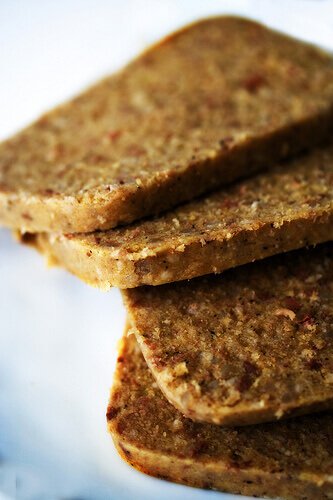
Hello world, meet Scrapple, a product that when fried with nothing else, tastes just like the name sounds, scrappy offal. If you must know what scrapple is made of, Wikipedia paints a pretty picture:
Scrapple is typically made of hog offal, such as the head, heart, liver, and other scraps, which are boiled with any bones attached (often the entire head), to make a broth. Once cooked, bones and fat are discarded, the meat is reserved, and (dry) cornmeal is boiled in the broth to make a mush. The meat, finely minced, is returned, and seasonings, typically sage, thyme, savory, and others are added. The mush is cast into loaves and allowed to cool thoroughly until gelled.
I don’t know about you, but thank goodness for sage, thyme and savory. The thought of jellied pig snout without those herbs just sends shivers throughout my frail, virgin body.
My main strategy when developing this recipe, was really, “how the hell do I transform something so utterly disgusting into a flavorful fried rice that even the pickiest eater would enjoy (as long as I didn’t let on what scrapple was.)
I chose 3 of the most pungent Asian ingredients that I had on hand: fresh chilies, fish sauce and garlic. Now, I know some of you would say that fish sauce sounds just as disgusting as scrapple, since basically a vat of stinky, fermented fish. But it’s a Southeast Asian staple and I’m being SO hypocritical right now. But did you know that your beloved Worcestershire sauce also contains a version of fish sauce? Dude. I KNOW! If only the makers of scrapple had marketing smarts too – and named their product something a little appealing than horse shit.
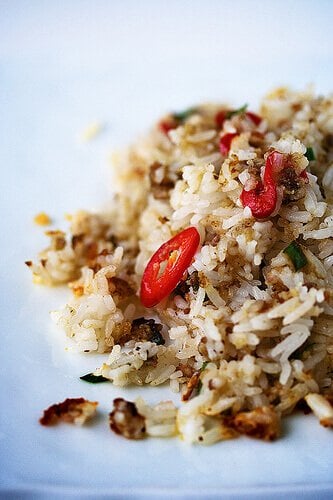
Because scrapple contains cornmeal, it crumbles pretty easily when fried, so I treated it like ground beef. First, I cut the scrapple into small cubes and stir fried it, using my spatula to break it up even further.
Scrapple Fried Rice with Fresh Chilies and Garlic
serves 2
1 1/2 tablespoons cooking oil, divided
1 teaspoon finely minced garlic
1 stalk scallion, minced
1 thinly sliced fresh chili (like Thai bird’s eye or jalepeno)
1/2 cup chopped scrapple
2 cups cooked, leftover rice (grains separated with a fork)
3/4 teaspoon fish sauce (substitute with 1 to 2 tsp soy sauce)
freshly ground black pepper
In a wok or large saute pan, heat just 1 tablespoon of the cooking oil over high heat. When the oil is very hot, add the scrapple and fry until browned, about 1 minute. Push the scrapple towards the outer edges of the wok, clearing a space in the middle to fry the aromatics. Turn the heat to medium, add the remaining 1/2 tablespoon of cooking oil and immediately add the garlic, scallion and fresh chilies. Stir fry for 15 seconds, until you can smell the fragrance of the aromatics. Turn your heat to high and add the rice. Use your spatula to mix all the ingredients thoroughly and at the same time spreading the rice and ingredients to use as much of the cooking surface of the wok as possible.
Now just leave it alone for 30 seconds. Don’t stir, poke or prod. Let the rice grains heat up, which basically will re-steam the rice. Once the rice has heated up, use your spatula to stir and flip the mixture. Pour the fish sauce slowly around the outer edges of the wok – the heat of the wok will help evaporate the fish sauce as it moves down the sides. Stir and flip the rice well again, to mix the fish sauce throughout. Season with black pepper. Let rice continue to cook until each of rice grain is hot.
***
Spam Fried Rice with Pineapple

Wow, what a voluptuous fan of Spam! Spread it all out, hot stuff!
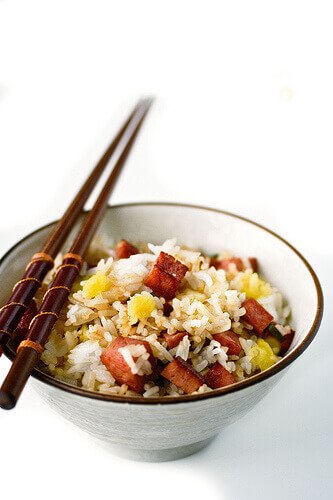
This was a no-brainer…I’ve previously have professed my love for Spam, in the Ode to Spam in the Style of Seuss, and I wanted to create a simpler, more refreshing version of Spam Fried Rice. My recipe calls for canned pineapple – but of course, you can use fresh pineapple, but hey…we’re going with the whole canned and processed theme here.
Spam Fried Rice with Pineapple
serves 2
2 teaspoons cooking oil
1/2 cup diced spam
1 teaspoon grated fresh ginger
1 stalk scallion, minced
1/4 cup crushed or 1/8 inch diced pineapple (canned or fresh)
2 cups cooked, leftover rice (grains separated)
1 to 2 teaspoons soy sauce
1/2 teaspoon sesame oil
In a wok or large saute pan, heat the cooking oil over medium-high heat. When the oil is hot but not smoking, add the diced spam and fry until browned on all sides, about 1 minute. Push the spam towards the outer edges of the wok, clearing a space in the middle to fry. You should still have a bit of oil left that is pooled in the middle of the wok. Turn the heat to low, add the add the ginger, scallions and pineapple. Stir fry for 15 seconds, until fragrant. Turn your heat to high and immediately add the rice. Use your spatula to mix all the ingredients thoroughly and at the same time spreading the rice and ingredients to use as much of the cooking surface of the wok as possible.
Now just leave it alone for 30 seconds. Don’t stir, poke or prod. Let the rice grains heat up, which basically will re-steam the rice. Once the rice has heated up, use your spatula to stir and flip the mixture. Pour the soy sauce sauce slowly around the outer edges of the wok – the heat of the wok will help evaporate the soy sauce as it moves down the sides. Stir and flip the rice well again, to mix the ingredients throughout. Finish with sesame oil and stir well. Let rice continue to cook until each of rice grain is hot.
***
Pork Roll Fried Rice with Shitake Mushrooms and Red Bell Pepper
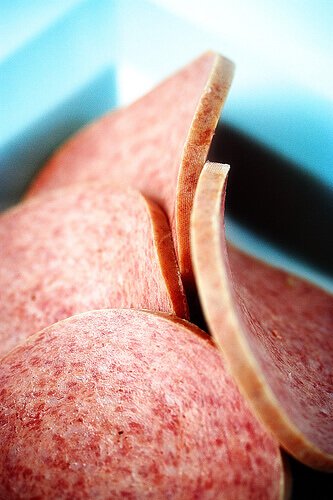
“Come ‘on, baby, look sexy for the camera….WORK IT!….Twirl and look over your shoulder now!…..YEAH BABY”
I had no idea there was such a thing as Pork Roll until I went shopping for Scrapple! The meat manager actually went around the store with me, helping find the scrapple (frozen section) and then also brought me to the refrigerated bacon and sausage section to hand me a package of Pork Roll. Four slices come per package, and it’s used in a regional specialty called “The Jersey Breakfast” – fried pork roll, egg and cheese sandwich. If you’re not lucky enough to find Pork Roll at your market, substitute with that strange oval-ish shaped canned ham. But then you’d have to buy that big can and only use a half cup diced. I have no idea how to eat that stuff outside of fried rice. I guess you could make the Jersey Breakfast sandwiches the next day from leftover canned ham.
Pork roll is basically coursely ground pork shoulder, and to me, is a Gucci-er version of spam. So I had to up the ante and use some fancy ingredients like fresh shitake mushrooms and fresh red bell peppers. Instead of plain ‘ol soy, I used Maggi sauce, a very popular condiment in Asia (even though its origins are Swiss). I’ve seen this seasoning at most major supermarkets and of course Asian markets too. I believe Maggi sauce even has a big cult following including myself!…. 😉
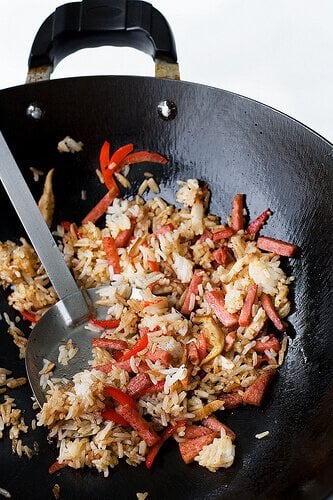
We were going for the casually tossed, grunge look for this photoshoot.
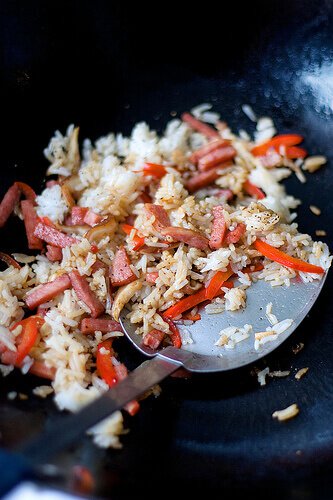
Pork Roll Fried Rice with Shitake and Bell Peppers
serves 2
2 teaspoons cooking oil
1/2 cup sliced pork roll
4 fresh shitake mushrooms, thinly sliced
1/2 red bell pepper, thinly sliced
2 cups cooked, leftover rice (grains separated)
1 teaspoon Chinese rice wine
1 teaspoon Maggi sauce (substitute with 1 to 2 teaspoons soy sauce)
In a wok or large saute pan, heat the cooking oil over medium-high heat. When the oil is hot but not smoking, add the pork roll and fry until browned, about 1 minute. Push the pork roll towards the outer edges of the wok, clearing a space in the middle to fry. You should still have a bit of oil left that is pooled in the middle of the wok. Turn the heat to low, add the shitake and bell pepper. Stir fry for 30 seconds, until softened. Turn your heat to high and immediately add the rice. Use your spatula to mix all the ingredients thoroughly and at the same time spreading the rice and ingredients to use as much of the cooking surface of the wok as possible.
Now just leave it alone for 30 seconds. Don’t stir, poke or prod. Let the rice grains heat up, which basically will re-steam the rice. Once the rice has heated up, use your spatula to stir and flip the mixture. Pour the Maggi sauce and the rice wine sauce slowly around the outer edges of the wok – the heat of the wok will help evaporate the sauce as it moves down the sides. Immediately, stir and flip the rice well again, to mix the ingredients throughout. Let rice continue to cook until each of rice grain is hot.
***
Vienna Sausage Fried Rice with Kaffir and Lemongrass
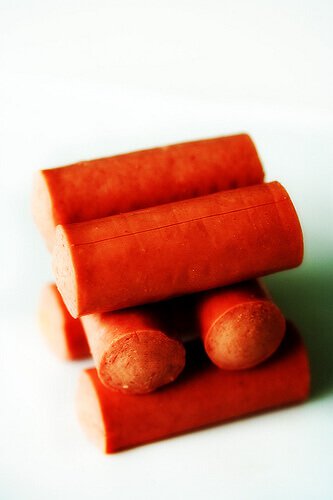
Went for minimalistic architecture – symmetrical, clean, lines. Very sleek and slimming!
I admit to eating an entire can of Vienna Sausages – straight out the can at room temperature. LOVE IT. We used to eat these little turds fried for breakfast in Hong Kong. I thought it would be great to put a Southeast Asian twist to this fried rice – and use thin slivers of lemongrass and torn kaffir lime leaves – both from my garden, but you can find at most Asian markets. If they don’t have fresh lemongrass or kaffir, ask for either in frozen form.
To prepare lemongrass, measure about 4-6 inches from the bottom and cut. Discard the scratchy, long leaves and keep the bottom, white bulb part. Peel off the outermost leaves and use a very sharp chef’s knife to cut paper-thin slivers. If you’re not capable of doing this, grab a microplane grater and just grate the bottom 4 inches of the bulb. It’s a pretty fibrous grass, and if you cut into huge chunks, you’ll end up chewing like a cow. Not so lady-like.
For the Kaffir, take a single leaf and tear in several spaces, stopping at the spine to keep the leaf intact. You won’t actually eat this leaf, but exposing the inner part of the leaf will fragrance your entire dish.

Even the bowl is sleek and slimming!
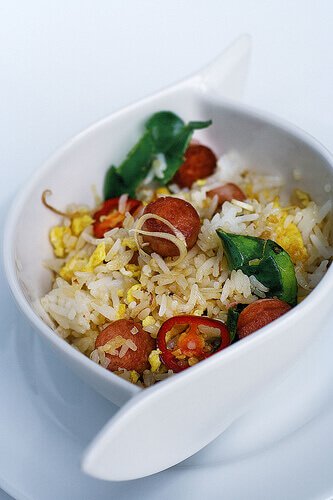
Vienna Sausage Fried Rice with Kaffir and Lemongrass
3 teaspoons cooking oil, divided
1/2 cup Vienna sausage, each link cut into 4 pieces
1 tablespoon fine rings of lemongrass (see note)
3 kaffir lime leaves, torn in several places to spine
1 tablespoon sliced chilies
2 eggs, beaten
2 cups cooked, leftover rice (grains separated)
1 1/2 teaspoons fish sauce (substitute with 1-2 teaspoons soy sauce)
In a wok or large saute pan, heat just 2 teaspoons of cooking oil over medium-high heat. When the oil is hot but not smoking, add the Vienna sausage and fry until browned, about 1 minute. Push the sausage towards the outer edges of the wok, clearing a space in the middle to fry. You should still have a bit of oil left that is pooled in the middle of the wok. Turn the heat to low, add the lemongrass, kaffir leaves and chilies. . Stir fry for 30 seconds, until fragrant.
Now push those aromatics up to the sides of the wok to clear space again in the middle. Turn the heat to high and add the remaining 1 teaspoon of cooking oil and let that heat up to hot but not smoking. Add the egg and fry the egg, swirling gently to break up the egg. Cook the egg until firm, about 1 minute.
Add the rice. Use your spatula to mix all the ingredients thoroughly and at the same time spreading the rice and ingredients to use as much of the cooking surface of the wok as possible.
Now just leave it alone for 30 seconds. Don’t stir, poke or prod. Let the rice grains heat up, which basically will re-steam the rice. Once the rice has heated up, use your spatula to stir and flip the mixture. Pour the fish sauce slowly around the outer edges of the wok – the heat of the wok will help evaporate the sauce as it moves down the sides. Immediately, stir and flip the rice well again, to mix the ingredients throughout. Let rice continue to cook until each of rice grain is hot.
***
If you enjoyed this post, will you please click on “Stumble This” or “Digg” for me? The icons are right below this area here. Thank you!

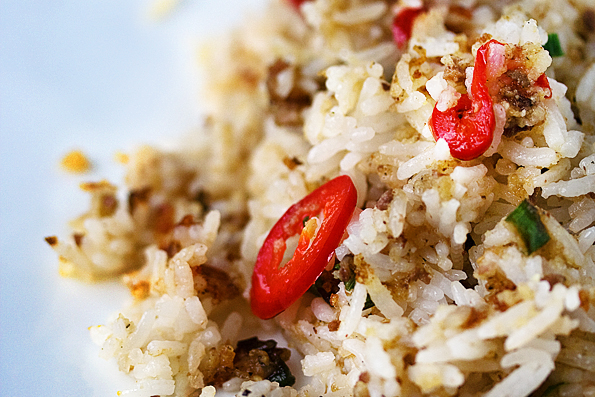




What a hoot! A woman after my own heart. With your refined palate, you admit to eating Vienna sausages! I didn’t think they made them just for me. One of my guilty pleasures…eaten out of the can, halved and placed on saltines. Guess you could call them a poor man’s hors d’oeuvre.
These are amazing ideas for fried rice. It is so perfect to eat friend rice in the morning and it is so amazing that we can do it in many ways according to the taste that we want. But most of the time I save leftover so that the following day we have a delicious fried rice with our leftover in it.
Hi,I really enjoy your site,just came across it a few days ago.I love “Little Smokies” I fix a crock pot of them with onions for the Bears Games,and OD on them, Love that salty,pork favor.Many some day you’ll come up with one of your great recipes using those,it would be something special. Thanks for a great foodie blog! moe
You know, the other day, I was thumbing through an old Julia Child cookbook “The Way To Cook” and she tells you HOW to make Scrapple! I was like, OMG, I totally know what that is, thanks to you, Jaden! Except I have a feeling Julia Child never considered scapple in fried rice….
Thanks for sharing Jaden!
I love scrapple – always have some frozen, ’cause it is hard to find in the South. I am partial to RAPPA hot scrapple.
http://www.rapascrapple.com/
Click here if you can’t find scrapple in your neck of the woods.
LOL my dad was born and raised in Hawaii and because of this we were raised to believe that SPAM was a delicacy and Vienna Sausage was “special.” My mom makes a great SPAM fried rice. In his retirement my dad has perfected a killer SPAM musubi recipe with a special teriyaki type glaze that he makes and shares with anyone standing within 5 feet of him, anytime, anywhere. Love your photos.
Forget the scrapple — go with head cheese.
How did you like the scrapple? I’m a huge fan of spam and vienna sausage, but didn’t really like scrapple. You might also like “pork roll”.
Scrapple is best eaten deep fried with a sweet breakfast dish, like french toast. The whole then gets covered in syrup and is heavenly! A lot of people can’t get past whats in it, but several places in philly make their own these days and use better quailty product. Delish!!
I’m loving the Spam revolution and am inching closer and closer to buying a can myself!
My husband is PA Dutch. He grew up on scrapple, or in the local dialect, panhas(I think). The closest European equivalent to scrapple is haggis.
Double dog dare ya to do something with that Scottish sausage.
I have a much better and less gutsy recipe for scrapple that involves muscle.
It is actually quite good. You are a brave, brave lady to tackle scrapple!
I’m pretty sure you just kicked it up a notch for me. I am not usually big on fried rice, but if you’re adding meat, I’m in!
That’s what I love about both fried rice and omelets _ basically you can put anything in it and it will always taste good. 😉
Um, I believe it’s, Meat Adventure. Or at least that’s how we spell it in my circle of nutcases.
xo, Biggles
Ahhh Spam !!!!Spam sandwiches with lots of sweet chili sauce was a childhood fav.
This brings back memories Jaden!
I love fried rice. This post of yours hit me right between the eyes!!!
You totally crack me up.
a great looking dish, and a completely awesome bowl. Where did you get that?
JADEN: Villeroy + Bach clearance outlet!
Dear jaden …its so fantastic to hear from you! I would love to see ur collection of magnets….send them soon to my event:-)
Regards,
Veda
Jaden, I’m loving these fried rice combos. I’ll say that from the options, I’ve only had spam. Scrapple still frightens me, but if you were to make it for me, I’d try it 🙂
Those sorts of meats were cooked in my mess hall in the army. Yes I did make a few nasty, high caloric and carb sandwiches with them, instant head buzz, but now I take omega pills.
Thanks Jaden for the memories of mystery meat!
Wow..you make Scrappel look sooo pretty!
Thanks for stopping by my blog!
I never thought to look up other food bloggers here in Tampa!
Yes we should have a Tampa Foodie Convention!LOL
All my friend think I am such a dork for having a food blog, but screw em..I love cooking and food and I love photography!
I admire you now more than ever Jaden! That’s quite an accomplishment. You turned something kinda gross into a work of art. Reminds me of how my single working mom turned out great dishes on a budget. And by the way, I recently discovered fish sauce and love it!
Nicely done Jaden! Very creative. I love scrapple, ONLY HABBERSET!!!!
Being from Philadelphia, it was a breakfast staple. In school though, they somethimes served it to us for dinner in large thick slices with maple syrup and a side of mashed potatoes. I prefer the thinly sliced crispy type.
I blogged about it and creamed chipped beef a while ago. Check it out when you get a chance:http://mrorph.com/foodblog/index.php?title=a-true-philly-breakfast&more=1&c=1&tb=1&pb=1
Jaden – Loved this post! I am no expert, but I think these are definitely the best photos you have ever taken. The meat products look extremely appetizing and it is no easy task. Both stumbled and dugg!
Being a Filipino, I loooooove Spam and vienna sausage. Being a Jersey girl, I loooooove Taylor ham aka pork roll! I’m not too sure I’d try the Scrapple though…man, why did I have to read the part where you listed what it’s made of?? I have yet to try fish sauce (we call it “patis”) in fried rice, I use Knorr liquid seasoning (aka Maggi’s competitor) or if I’m out of Knorr, soy sauce (has to be a Filipino brand though, using Kikkoman just doesn’t make it taste the same).
Every time I visit your blog, my tummy rumbles. =)
i stared at the scrapple on tastespotting and was confused with the fact that you had meat in quotes. lips and a**holes of a pig IS meat in my book! love that you used two of my hometown classics – scrapple and pork roll.
if you’re interested, check out my older post about scrapple and pork roll. It’s almost an ode to them both! what you don’t know won’t kill you!
http://www.weareneverfull.com/dont-pork-this-roll-or-scrap-this-scrapple-the-dirty-culinary-pride-of-south-jerseyphilly/
These are definitely some interesting combination’s. I’ve actually never had scrapple before.
Every good Cincinnatian knows goetta is far superior to scrapple. I see goetta fried rice in my future.
This philly girl LOVES scrapple! and I’m sort of offended that it was included in a post about crappy canned meats like spam and vienna sausages. Scrapple is definitely classier (and more delicious) than that. Regardless of the slight, the recipe looks good and I think I’ll try it sometime soon.
Every one of your posts totally crack me up! A friend of mine from PA made scrapple last summer, and I could barely get one bite down. Not my thing, but apparently it’s quite popular in PA!
I looooooove Spam. people look at me funny when I say that it goes well in fried rice (or fried, crispy, atop ramen noodles) but i think it must be an Oriental thing, only my Chinese friends understand!
Well…now…am I supposed to get Scrabulous with Scrapple ? or play Scrabble with Scrapple? :O …no wonder I can’t do Scrapple Fried Rice…I could only play with words! I can smell the robust fragrance in all your fried rice…IT”S THE MEAT, baby!
Taylor pork roll?! My husband is from Jersey and introduced me to this delicacy (ha!
Have to say it’s quite sinful and delicious!
Spam fried rice /w pineapples is one of our favorites! Try adding a little diced yellow onion next time for a added flavor element. =)
Very cool! I’ve got to try that Spam Fried Rice.
I’m inspired…tomorrow is 49 cent hamburger day at McD’s..I could order four…throw away the buns…
We don’t get scrapple here in Canada I think (thank god!). However, we have a lot of haggis-eaters come Robbie Burns day. We celebrate it every year in our staffroom. Bagpipe music, Burns poetry reading and haggis for everyone. We even have this “Gung Haggis Faat Choy” event in Vancouver–kind of a cross-cultural thingy. You’ve gotta have fun with food, right? Inspiring post for how you can make anything edible in fried rice!
put the whole lot together for a sick sick SICK meat orgy, baby! scrapple, spam, corned beef, vienna sausages, pork roll, faux crab meat, and throw in some stinky fishballs altogether. it’ll be like the hottest club in hongkong, full of hotnesses making out with each other.
minus the drugs.
or maybe throw in some grass(corriander)and let everyone go highhhh
SICK SICK…SICKKK! station ur burliest party doorman as the queue shall be a long one, baby.
put me on VIP list.
Scrapple sounds like a form of headcheese? I don’t think we have scrapple here in Canada, darn shame! I have never ever not have a can of Spam in the pantry…it’s an old reliable friend, always there, always at the ready….
I’m so hungry. Stuck at the office, yearning for some vienna sausages.
Though, I must say, my first introduction to Maggi sauce came from the fine pair over at http://eatingasia.typepad.com/
Theirs is my place to learn about what’s going on with food on the other side of the world without having to put up with Mr. Bourdain’s alcoholic ramblings or Mr. Zimmerman’s jokesy…. desire to eat every nasty thing in the world. (Granted, I absolutely love both shows, but they’re so easy to trash, sometimes you just can’t help yourself.)
A recipe involving scrapple? That’s instant win! My family is all from PA and it’s a favorite of mine. I even know a place local to me (in CO) that carries it. This will have to be tried immediately.
found via foodgawker — as a native of new jersey, i am very familiar with pork roll, which is also called Taylor Ham. I think Taylor Ham is a particular brand of pork roll, but it’s also used as a generic name, like how kleenex means any old tissue. this is definitely the most stylish presentation of taylor ham i’ve ever seen!
and scrapple too, for that matter. i love scrapple. a slice of scrapple, battered and fried, served with scrambled eggs and some hot sauce and hash browns… it’ll be the only thing you eat all day, but sometimes it just has to be done. some parts of southern jersey have scrapple, so i don’t have to cross any state borders 😀 i really like seeing non-breakfast applications of these foods, too!
i haven’t had the stomach to dare vienna sausages, yet. and i think i had spam maybe once, but everytime i see a picture of spam musubi or something i am willing to give it a second chance. your spam & pineapple rice definitely qualify as making me rethink my spam aversion.
Weiner stacker.
Scrapple is very famous here in PA but I don’t have the guts to try it 🙂 but give me Spam anytime. I will put it in my fried eggs, fried rice or eat it as it is. Is time to open a can of SPAM for dinner 🙂
You’ve done great things here, but my canned meat snobbery means I’m not sure I’ll be trying these too soon. 😉 Heck, this could be a great Top Chef kind of challenge…lol
If there’s one out there, you definitely deserve the “way to be creative” award! I’m still laughing over your comment about a fascination about meat that comes in it’s own coffin!
We just had a convo about canned meats and childhood memories with the neighbors, well, they talk I listened since I have never had Spam or Vienna sausages but they, and now you, almost made me want to try it!!
WOW, you actually made me want to eat spam after 30 years of not eating it! Beautiful!
Jaden,
Spam is without doubt the winner. As a matter of fact, there are 3 cans of Spam lite in our cupboard as I write. I can’t tell you how often my wife has cooked spam fried rice in Korea and here at home. We make our Spam fried rice with the leftovers in the fridge, including kimchi!
BTW, pan fried spam and kimchi… mighty tasty, and not the least bit salty… Steamed rice helps cut the salt, but so does a frosty, adult, hoppy beverage.
Cut some very firm tofu cut the same size of the spam, pan sear the tofu, serve with cooked kimchi. Dang, here I am giving away all the awsome ways Koreans cook spam. Great article!! Thanks
Hmmmn…. Spam is the winner, followed closely by the Vienna Sausages. Philippines (Filipinos) love SPAM so much that there is a new fast food place there now serving just SPAM in varied ways!
This is ingenious, Jaden!
you. are. so. my. hero. Vienna Sausage! I do believe that is a first! But spam is a staple in most islander households. Open any pantry and see the cans gleaming on the shelves.
Okay girl, I’m waiting to see a post on Vienna Sausage and cheese ball sushi. Hey, you might as well!!
Jaden, you are freaking me out.
One of my favorite things about Virginia:
You can order breakfast with both grits(south) and scrapple(north) on the same plate. Yum!
Way to upscale some rather downscale meat products! My dad had me hooked on Scrapple when I was a kid. Then I found out what was in it. Now I can’t bring myself to eat it though I miss the flavor of which I can still remember.
You should look in my moms pantry Jaden, there’s tons of spam, she would consider you her 3rd daughter and seventh child!
Nice variety on the another classic Asian comfort food.
I’ll “stumble” ya babe…:D
Only you can pull off a successful post on canned meat. Ha ha. You are so funny. I love how this was not a “polished” post by any means. In fact, based on the detailed description of scrapple, not sure I could muster myself to make this dish. Vienna sausage brings back a childhood nostalgia that’s for sure. By the way, I was honored to have you comment on my blog. Thanks for your feedback!
Haven’t had scrapple before, but Spam and Vienna sausage are prominent members of our pantry! As well as canned corned beef — these “meats” are all good with rice.
growing up, my mom made us eat all those ‘meats’…the scrapple only once, ’cause we sneaked a peek at the ingredients, 😮 and refused to eat it even when theatened with pain! but to be fair, we also ate a good deal of chorizo growing up, and it has a lot of the same stuff! but, when my son bit into a TOOTH (not his) eating it…well, no more for us!
Now, that’s what I call a spammylicious post 😀
I must say, those are good looking spam. Much better quality than what I use at the moment 😛
You are a sick, sick bitch.
I can’t seem to get enough.
Hahahahaha! Wonderful article and some great recipes – reminds me of the “What’s In The Fridge Fried Rice” I make when there’s nothing else in the house to eat.
But don’t be dissing on scrapple. It’s second only to bacon in deliciousness. =)
As always, beautiful presentation – you almost made me want to try them…almost. These are probably the only recipes on your site I won’t try! I am a wuss when it comes to canned meat. 🙂 In Italy they have quite a bit of canned meat that I’ve never tried – the most popular brand is “Montana” if you want me to send you some!
I’m from New Jersey originally and have lived in Philly for years and you cannot get me to touch scrapple. But then again, I still fear the Spam.
That said, this Jersey girl-at-heart loves, loves, loves Taylor Pork Roll and your fried rice looks like a great way to use it. (When I’m not just frying it to a crisp and eating it with breakfast.)
I grew up with Scrapple. Cant find it here in the Midwest. The German loves Spam. It reminds him of some canned meat from home. I have to try the Spam fried rice for him. It will be a kick. Great ideas.
Ah grasshopperette, soon you may be ready for the penultimate utility pork meat product: North Carolina Liver Puddin’
http://en.wikipedia.org/wiki/Livermush
Ladies and gentlemen, start your defibrillator’s!
i also have a love of spam! when i was growing up the korean side of my family would pan fry it and then serve it over rice with soy sauce & sesame oil. (kind of reminds me of how american kids get stuck with hot dogs and macaroni for every meal?) in any case, i love it to this day! i even made it this week with a curried fried rice, but i didn’t think to add pineapple! i might have to break down and go buy another tin of spam for this week. 🙂
Hi Jaden,
Must share that “Ode to Spam in the style of Seuss” with my 2nd graders. They’ll love it since we are Spam eaters here on the island. The contest is over but Spam kelaguen is the way to eat it on Guam. Smash the spam, add onions, fresh lemon juice and boonie peppers and eat with hot steaming rice…gof mangi! (very good)
Oh yeah, that Spam fried rice looks like foods I remember from Saipan and Guam! OMG, you’ve brought back some 20 year old memories!
I’m liking the pork roll version with shitake and red bell pepper. I grew up in Guam, now live in Hawaii and my husband is Ilocano, so none of those processed meats sound too offal for this household. 🙂
mmm vienna sausage, we used to have them for breakfast too, sauteed in shoyu and sugar.
Jaden-
OK, an A Plus for creativity.
Another A Plus for presentation – they almost look good enough to eat.
As for the meat products – I’m going Kosher!
PS: Scrapple is a local Philly favorite.
steamy- i do believe you have a frail, virgin body…hahaha! thanks for the write up, typos and all. you are a great story teller and the pictures are once again, as appetizing as they look. sorry, no scrapples for me please.
Lady, u r amazing.
I think I still like the spam one best. =)
You are so funny! I have never had scrapple, but we do love us some spam out here in Hawaii. So thankful there is not a listing for spam ingredients! 🙂 We love our spam fried rice with soy sauce and oyster sauce … 🙂 I love your photography, you are incredible! 🙂